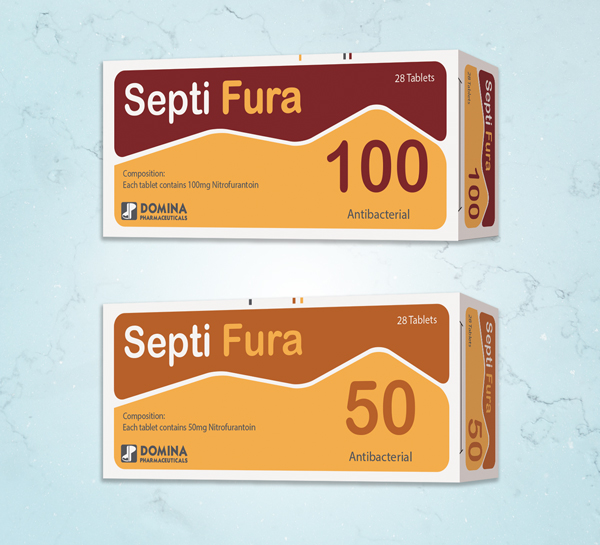
COMPOSITION:
Each tablet contains 50mg or 100mg Nitrofurantoin.
MECHANISM OF ACTION:
- Nitrofurantoin is a broad-spectrum antibacterial agent, active against the majority of urinary tract pathogens. The mechanism of action of Nitrofurantoin is the interfering with the energy supply for normal growth and maintenance of bacteria. They also bind to bacterial ribosomal proteins at different sites, resulting in disruption of bacterial protein synthesis. Transferable resistance to Nitrofurantoin is a rare phenomenon. There is no cross resistance to antibiotics and sulphonamides.
- The wide range of organisms sensitive to bactericidal activity include: Escherichia Coli, Enterococcus faecalis, Klebsiella species, Enterobacter species and Staphylococcus species.
- Most strains of Proteus and Serratia are resistant. All pseudomonas strains are resistant.
INDICATIONS:
- For the treatment of and prophylaxis against acute or recurrent, uncomplicated lower urinary tract infections or pyelitis either spontaneous or following surgical procedures.
- strains of Escherichia Coli, Enterococci, Staphylococci and Klebsiella.
Nitrofurantoin is specifically indicated for the treatment of infections when due to susceptible
DOSAGE:
- Adults: 1- Acute Uncomplicated Urinary Tract Infections →50mg four times
daily for seven days
2- Severe Chronic Recurrence → 100mg four times a day for seven days
3- Long Term Suppression → 50mg - 100mg once a day.
4- Prophylaxis →50mg four times daily for the duration of procedure and
3 days thereafter.
- Paediatric: Children over three months of age
1- Acute Urinary Tract Infections → 3mg/kg/day in four divided doses
for seven days.
2- Suppressive →1mg/kg, once a day.
- Elderly: As for normal adult.
SIDE EFFECTS:
Anorexia, nausea, vomiting, and diarrhea, acute and chronic pulmonary reactions (pulmonary fibrosis reported, possible association with lupus erythematosus - like syndrome), peripheral neuropathy also reported, hypersensitivity reactions (including angioedema, anaphylaxis, urticaria, rash and pruritus).
Rarely: Dermatitis, hepatitis, blood disorders and transient alopecia.
Super-infections by fungi or resistant organism such as pseudomonas may occur. However, these are limited to genitourinary tract.
CONTRAINDICATIONS:
- Hypersensitivity to nitrofurantoin or to any of the excipients.
- Patients suffering from renal dysfunction with a creatinine clearance of less than 60ml/minute or elevated serum creatinine.
- G6PD (Glucose-6-Phosphate dehydrogenase) deficiency.
DRUG INTERACTIONS:
- Decreased absorption with magnesium trisilicate.
- Decreased renal excretion of Nitrofurantoin by probenecid and sulfinpyrazone.
- Decreased anti-bacterial activity by carbonic anhydrase inhibitors and urine alkalisation.
PRECAUTIONS:
- Gastrointestinal reactions may be minimized by taking the drug with food or milk or by adjustment of dosage.
- Nitrofurantoin is not effective for the treatment of non-functioning kidney.
- Nitrofurantoin may be used with caution as short-course therapy only for the treatment of uncomplicated lower urinary tract infection in individual cases with an eGFR between 30-44 ml/min to treat resistant pathogens, when the benefits are expected to outweigh the risks.
- Nitrofurantoin should be used with caution in patients with pulmonary disease, hepatic dysfunction, neurological disorders, and allergic diathesis.
- Peripheral neuropathy and susceptibility to peripheral neuropathy, which may become severe or irreversible, has occurred and may be life threatening. Therefore, treatment should be stopped at the first signs of neural involvement.
- Nitrofurantoin should be used with caution in patients with anaemia, diabetes mellitus, electrolyte imbalance, debilitating conditions and Vitamin B deficiency.
- Discontinue treatment with Nitrofurantoin, if unexplained pulmonary, hepatotoxic, hematological or neurological syndromes occur.
- For long-term treatment, monitor patient closely for appearance of symptoms and other evidence of toxicity.
EFFECTS ON ABILITY TO DRIVE AND USE MACHINES:
Septi Fura does not interfere with the ability to drive or use machines.
USE IN PREGNANCY OR LACTATION:
- Nitrofurantoin is classified as category B, to be used only if clearly indicated in pregnancy.
- This drug is contraindicated in pregnant patients at term (38 to 42 weeks gestation), during labor and delivery, or when the onset of labor is imminent because of the possibility of hemolytic anemia due to immature erythrocyte enzyme systems (glutathione instability).
- This drug should be used during pregnancy up to 38 weeks gestation only if the benefit outweighs the risk.
- Nitrofurantoin is detected in trace amounts in breast milk, and should therefore be avoided in infants under three months of age as well as pregnant patients at term (during labour and delivery) because of the theoretical possibility of haemolytic anaemia in the foetus or in the newborn infant
PHARMACOKINETIC PROPERTIES:
1- Absorption: Orally administered Nitrofurantoin is readily absorbed in the upper gastrointestinal tract and is rapidly excreted in the urine. Nitrofurantoin is loosely bound to plasma albumin (60-70)% and the blood concentrations at therapeutic dosages are usually low
2- Elimination: Maximum urinary excretion usually occurs 2-4 hours after administration of Nitrofurantoin. It has an elimination half-life of about 30 minutes